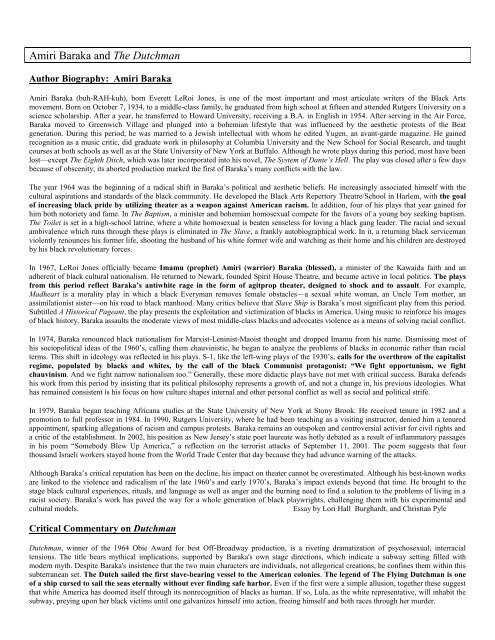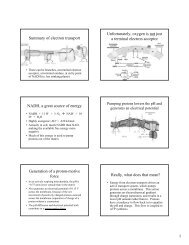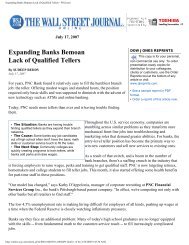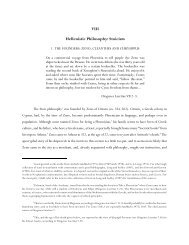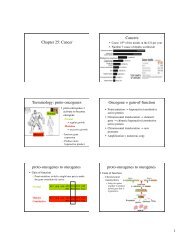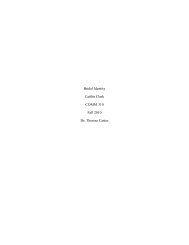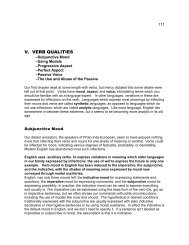Amiri Baraka and The Dutchman - UW-Parkside: Help for Personal ...
Amiri Baraka and The Dutchman - UW-Parkside: Help for Personal ...
Amiri Baraka and The Dutchman - UW-Parkside: Help for Personal ...
You also want an ePaper? Increase the reach of your titles
YUMPU automatically turns print PDFs into web optimized ePapers that Google loves.
<strong>Amiri</strong> <strong>Baraka</strong> <strong>and</strong> <strong>The</strong> <strong>Dutchman</strong><br />
Author Biography: <strong>Amiri</strong> <strong>Baraka</strong><br />
<strong>Amiri</strong> <strong>Baraka</strong> (buh-RAH-kuh), born Everett LeRoi Jones, is one of the most important <strong>and</strong> most articulate writers of the Black Arts<br />
movement. Born on October 7, 1934, to a middle-class family, he graduated from high school at fifteen <strong>and</strong> attended Rutgers University on a<br />
science scholarship. After a year, he transferred to Howard University, receiving a B.A. in English in 1954. After serving in the Air Force,<br />
<strong>Baraka</strong> moved to Greenwich Village <strong>and</strong> plunged into a bohemian lifestyle that was influenced by the aesthetic protests of the Beat<br />
generation. During this period, he was married to a Jewish intellectual with whom he edited Yugen, an avant-garde magazine. He gained<br />
recognition as a music critic, did graduate work in philosophy at Columbia University <strong>and</strong> the New School <strong>for</strong> Social Research, <strong>and</strong> taught<br />
courses at both schools as well as at the State University of New York at Buffalo. Although he wrote plays during this period, most have been<br />
lost—except <strong>The</strong> Eighth Ditch, which was later incorporated into his novel, <strong>The</strong> System of Dante’s Hell. <strong>The</strong> play was closed after a few days<br />
because of obscenity; its aborted production marked the first of <strong>Baraka</strong>’s many conflicts with the law.<br />
<strong>The</strong> year 1964 was the beginning of a radical shift in <strong>Baraka</strong>’s political <strong>and</strong> aesthetic beliefs. He increasingly associated himself with the<br />
cultural aspirations <strong>and</strong> st<strong>and</strong>ards of the black community. He developed the Black Arts Repertory <strong>The</strong>atre/School in Harlem, with the goal<br />
of increasing black pride by utilizing theater as a weapon against American racism. In addition, four of his plays that year gained <strong>for</strong><br />
him both notoriety <strong>and</strong> fame. In <strong>The</strong> Baptism, a minister <strong>and</strong> bohemian homosexual compete <strong>for</strong> the favors of a young boy seeking baptism.<br />
<strong>The</strong> Toilet is set in a high-school latrine, where a white homosexual is beaten senseless <strong>for</strong> loving a black gang leader. <strong>The</strong> racial <strong>and</strong> sexual<br />
ambivalence which runs through these plays is eliminated in <strong>The</strong> Slave, a frankly autobiographical work. In it, a returning black serviceman<br />
violently renounces his <strong>for</strong>mer life, shooting the husb<strong>and</strong> of his white <strong>for</strong>mer wife <strong>and</strong> watching as their home <strong>and</strong> his children are destroyed<br />
by his black revolutionary <strong>for</strong>ces.<br />
In 1967, LeRoi Jones officially became Imamu (prophet) <strong>Amiri</strong> (warrior) <strong>Baraka</strong> (blessed), a minister of the Kawaida faith <strong>and</strong> an<br />
adherent of black cultural nationalism. He returned to Newark, founded Spirit House <strong>The</strong>atre, <strong>and</strong> became active in local politics. <strong>The</strong> plays<br />
from this period reflect <strong>Baraka</strong>’s antiwhite rage in the <strong>for</strong>m of agitprop theater, designed to shock <strong>and</strong> to assault. For example,<br />
Madheart is a morality play in which a black Everyman removes female obstacles—a sexual white woman, an Uncle Tom mother, an<br />
assimilationist sister—on his road to black manhood. Many critics believe that Slave Ship is <strong>Baraka</strong>’s most significant play from this period.<br />
Subtitled A Historical Pageant, the play presents the exploitation <strong>and</strong> victimization of blacks in America. Using music to rein<strong>for</strong>ce his images<br />
of black history, <strong>Baraka</strong> assaults the moderate views of most middle-class blacks <strong>and</strong> advocates violence as a means of solving racial conflict.<br />
In 1974, <strong>Baraka</strong> renounced black nationalism <strong>for</strong> Marxist-Leninist-Maoist thought <strong>and</strong> dropped Imamu from his name. Dismissing most of<br />
his sociopolitical ideas of the 1960’s, calling them chauvinistic, he began to analyze the problems of blacks in economic rather than racial<br />
terms. This shift in ideology was reflected in his plays. S-1, like the left-wing plays of the 1930’s, calls <strong>for</strong> the overthrow of the capitalist<br />
regime, populated by blacks <strong>and</strong> whites, by the call of the black Communist protagonist: “We fight opportunism, we fight<br />
chauvinism. And we fight narrow nationalism too.” Generally, these more didactic plays have not met with critical success. <strong>Baraka</strong> defends<br />
his work from this period by insisting that its political philosophy represents a growth of, <strong>and</strong> not a change in, his previous ideologies. What<br />
has remained consistent is his focus on how culture shapes internal <strong>and</strong> other personal conflict as well as social <strong>and</strong> political strife.<br />
In 1979, <strong>Baraka</strong> began teaching Africana studies at the State University of New York at Stony Brook. He received tenure in 1982 <strong>and</strong> a<br />
promotion to full professor in 1984. In 1990, Rutgers University, where he had been teaching as a visiting instructor, denied him a tenured<br />
appointment, sparking allegations of racism <strong>and</strong> campus protests. <strong>Baraka</strong> remains an outspoken <strong>and</strong> controversial activist <strong>for</strong> civil rights <strong>and</strong><br />
a critic of the establishment. In 2002, his position as New Jersey’s state poet laureate was hotly debated as a result of inflammatory passages<br />
in his poem “Somebody Blew Up America,” a reflection on the terrorist attacks of September 11, 2001. <strong>The</strong> poem suggests that four<br />
thous<strong>and</strong> Israeli workers stayed home from the World Trade Center that day because they had advance warning of the attacks.<br />
Although <strong>Baraka</strong>’s critical reputation has been on the decline, his impact on theater cannot be overestimated. Although his best-known works<br />
are linked to the violence <strong>and</strong> radicalism of the late 1960’s <strong>and</strong> early 1970’s, <strong>Baraka</strong>’s impact extends beyond that time. He brought to the<br />
stage black cultural experiences, rituals, <strong>and</strong> language as well as anger <strong>and</strong> the burning need to find a solution to the problems of living in a<br />
racist society. <strong>Baraka</strong>’s work has paved the way <strong>for</strong> a whole generation of black playwrights, challenging them with his experimental <strong>and</strong><br />
cultural models. Essay by Lori Hall Burghardt, <strong>and</strong> Christian Pyle<br />
Critical Commentary on <strong>Dutchman</strong><br />
<strong>Dutchman</strong>, winner of the 1964 Obie Award <strong>for</strong> best Off-Broadway production, is a riveting dramatization of psychosexual, interracial<br />
tensions. <strong>The</strong> title bears mythical implications, supported by <strong>Baraka</strong>'s own stage directions, which indicate a subway setting filled with<br />
modern myth. Despite <strong>Baraka</strong>'s insistence that the two main characters are individuals, not allegorical creations, he confines them within this<br />
subterranean set. <strong>The</strong> Dutch sailed the first slave-bearing vessel to the American colonies. <strong>The</strong> legend of <strong>The</strong> Flying <strong>Dutchman</strong> is one<br />
of a ship cursed to sail the seas eternally without ever finding safe harbor. Even if the first were a simple allusion, together these suggest<br />
that white America has doomed itself through its nonrecognition of blacks as human. If so, Lula, as the white representative, will inhabit the<br />
subway, preying upon her black victims until one galvanizes himself into action, freeing himself <strong>and</strong> both races through her murder.
Lula, the protagonist, controls scene 1. She enters from behind Clay, initiates their confrontive conversation, <strong>and</strong> sits beside him. Even<br />
though he is uncom<strong>for</strong>table, she makes seductive overtures. Her accurate assessment of his middle-class background <strong>and</strong> assimilationist<br />
behavioral mask also fascinates him into continuing their conversation. Lula, the oppressor, condescendingly sees Clay as a stereotype <strong>and</strong><br />
comm<strong>and</strong>s the topics with which they essentially talk at each other. By admitting that she is a liar—<strong>and</strong> later, that she is insane—Lula <strong>for</strong>ces<br />
him into the untenable situation of having to process each of her statements as fact or fiction. Furthermore, it is she who offers Clay an apple<br />
that he accepts; critics have made much of the possible Adam <strong>and</strong> Eve analogy. Lula is also the initiator of physical aggression, first running<br />
her h<strong>and</strong> along Clay's leg <strong>and</strong> later harshly grabbing <strong>and</strong> shaking his wrist.<br />
Clay, in suit <strong>and</strong> striped tie despite the summer heat, has assimilated into the white world. He does not wish to call attention to himself. Clay<br />
sees Lula also as a stereotype—of the liberal white woman fascinated by fantasies of interracial sexual intercourse. Momentarily excited by<br />
her, he allows himself to become vulnerable by adapting to her mercuric emotional shifts.<br />
In scene 2, as Lula describes her party plans in seductive detail, Clay begins to make physical advances. <strong>The</strong>ir dialogue, strikingly fast-paced<br />
from the play's opening lines, intensifies into a dueling rhythm as they both become more openly confrontational. <strong>The</strong>y even capture the<br />
attention of normally apathetic fellow subway riders, who watch their interaction with some interest. A major shift occurs when Lula<br />
unmasks Clay, accusing him of having escaped to her (the white) side. Clay assumes control, <strong>and</strong> Lula defends herself with hysterics, singing<br />
<strong>and</strong> dancing in the train aisle. Clay refuses every invitation to join her until she goads him to restrain her by warning him that he is dying<br />
because of his assimilation, that he must release himself from his self-imposed bonds. He wrestles her (as well as the drunk who attempts to<br />
defend her) into submission, slapping her with full strength.<br />
<strong>Baraka</strong> sees dance as an ultimate expression of life. Lula's hysterical invitation, however, assumes a double meaning. Even though she may<br />
be offering Clay an apparent passageway out of his self-victimization, she is simultaneously inviting him into a new bondage: life on her<br />
terms. With no viable means of regaining his mask or escaping, Clay is finally free to expunge his rage. He erupts into a devastating diatribe<br />
that avows his contempt <strong>for</strong> those who surround themselves with illusions to avoid reality, his homicidal hatred of whites, <strong>and</strong> his need to<br />
assimilate so as not to commit mass murder. According to Clay, black art <strong>and</strong> music are escape valves that would be unnecessary if the artists<br />
would simply exterminate whites: “A whole people of neurotics, struggling to keep from being sane. And the only thing that would cure the<br />
neurosis would be your murders.”<br />
Clay defeats himself, however, by retreating tiredly from an insistence upon action to the safety of words. He concludes with a warning not to<br />
trust assimilated blacks because someday they will embark on a genocidal rampage, using as their justification the same white<br />
rationalizations they have been taught.<br />
As Clay bends to gather his books, Lula stabs him twice; after he has destroyed her illusions of him, she must destroy him. Whether her<br />
actions are premeditated can be interpreted dramatically through her interactions with the other passengers. Her earlier admission that she<br />
knows them even more intimately than she knows Clay <strong>and</strong> their easy acquiescence in disposing of his body suggest either complicity or a<br />
compelling fear. That their presence as her “crew” is prearranged is in keeping with the <strong>Dutchman</strong> myth. Her preparation to start the cycle<br />
once more with another young black who enters the car further supports the mythical interpretation.<br />
In <strong>Dutchman</strong>, <strong>Baraka</strong> dramatizes two of his major themes. <strong>The</strong> first is that dehumanizing sexuality, in any <strong>for</strong>m, leads to death. Clay <strong>and</strong><br />
Lula's sexual interaction is simply another layer of masking. It is sterile, with no spiritual or emotional intimacy. <strong>Baraka</strong>'s second theme is<br />
that psychic paralysis leads to annihilation. Clay has the opportunity to survive until he is caught in his own self-destructive trap. As a<br />
poet, he retreats into words <strong>and</strong> poetry when challenged because they are safe <strong>and</strong> com<strong>for</strong>table, even when he recognizes the need <strong>for</strong> action.<br />
He does not see his art's potential as a motivating agent <strong>for</strong> change, <strong>and</strong> he reverts to passive resistance, giving up. Consequently, his art, too,<br />
is sterile. It is Lula who survives, by committing the extreme guerrilla action in murdering him. Essay by Kathleen Mills<br />
A powerful one-act drama, <strong>Dutchman</strong> brought immediate <strong>and</strong> lasting attention to poet <strong>Amiri</strong> <strong>Baraka</strong>. <strong>The</strong> play is a searing two-character<br />
confrontation that begins playfully but builds rapidly in suspense <strong>and</strong> symbolic resonance. Set on a New York subway train, <strong>Dutchman</strong> opens<br />
with a well-dressed, intellectual, young African American man named Clay absorbed in reading a magazine. He is interrupted by Lula—a<br />
flirtatious, beautiful white woman a bit older than he. As Lula suggestively slices <strong>and</strong> eats an apple, she <strong>and</strong> Clay tease each other with<br />
bantering talk that becomes more <strong>and</strong> more personal. She reveals little about herself, but Lula is clearly in control of the conversation <strong>and</strong> the<br />
situation as she perceptively <strong>and</strong> provokingly challenges Clay’s middle-class self image. Lula is, in fact, a bit cruel. “What right do you have<br />
to be wearing a three-button suit <strong>and</strong> striped tie?” she asks. “Your gr<strong>and</strong>father was a slave, he didn’t go to Harvard.” Aware of his<br />
insecurities, Lula dares Clay to pretend “that you are free of your own history.”<br />
Clay’s insecurities about his race, social status, <strong>and</strong> masculine prowess—slowly revealed as his answers shift from machismo to<br />
defensiveness—become the targets <strong>for</strong> Lula’s increasingly direct taunts. Eventually, Lula’s attempt to <strong>for</strong>ce Clay to see in himself the<br />
negative stereotypes of the black male—as either oversexed stud or cringing Uncle Tom—goad him into an eloquently bitter tirade. Black<br />
music <strong>and</strong> African American culture, he tells her, are actually repressions of a justified rage that has kept African American people sane in<br />
the face of centuries of oppression. Clay seems as desperate to prove this to himself as he is to convince Lula. He does not seem to know<br />
whether the rage or the repression has taken the greater toll on African American sanity. <strong>The</strong> scene escalates in dramatic <strong>for</strong>ce until Lula<br />
unexpectedly stabs Clay to death.<br />
<strong>Baraka</strong> has said that <strong>Dutchman</strong> “is about how difficult it is to become a man in the United States.” Nevertheless, the ancient symbolism<br />
of apple <strong>and</strong> temptation, <strong>and</strong> the myth of the ghostly pirate ship, <strong>The</strong> Flying <strong>Dutchman</strong>, used in Richard Wagner’s opera <strong>and</strong> other literary<br />
works, are carefully suggested in <strong>Baraka</strong>’s play <strong>and</strong> amplify the dimensions of racial conflict. Essay by Lorenzo Thomas


